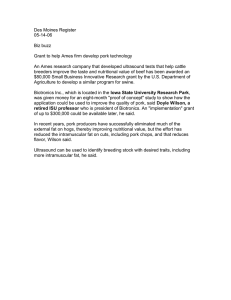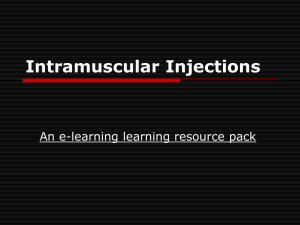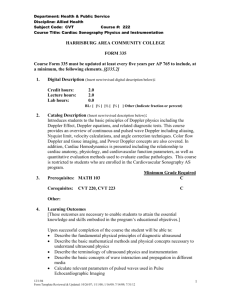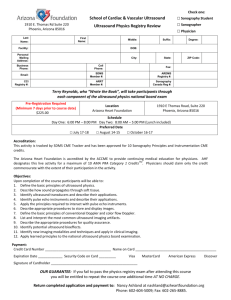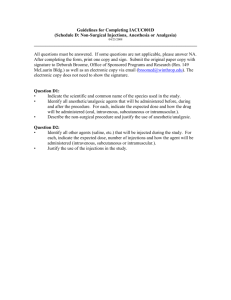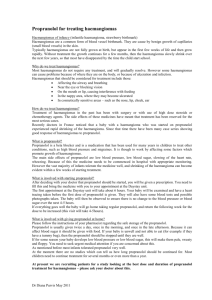Document 14233610
advertisement
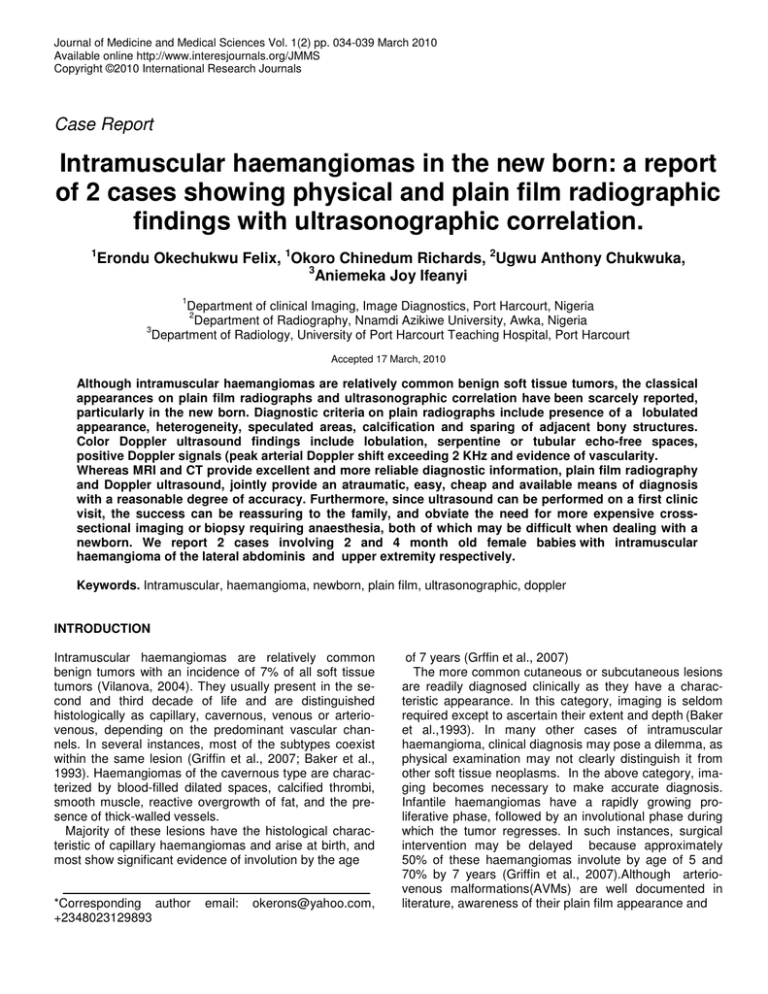
Journal of Medicine and Medical Sciences Vol. 1(2) pp. 034-039 March 2010 Available online http://www.interesjournals.org/JMMS Copyright ©2010 International Research Journals Case Report Intramuscular haemangiomas in the new born: a report of 2 cases showing physical and plain film radiographic findings with ultrasonographic correlation. 1 Erondu Okechukwu Felix, 1Okoro Chinedum Richards, 2Ugwu Anthony Chukwuka, 3 Aniemeka Joy Ifeanyi 1 Department of clinical Imaging, Image Diagnostics, Port Harcourt, Nigeria 2 Department of Radiography, Nnamdi Azikiwe University, Awka, Nigeria 3 Department of Radiology, University of Port Harcourt Teaching Hospital, Port Harcourt Accepted 17 March, 2010 Although intramuscular haemangiomas are relatively common benign soft tissue tumors, the classical appearances on plain film radiographs and ultrasonographic correlation have been scarcely reported, particularly in the new born. Diagnostic criteria on plain radiographs include presence of a lobulated appearance, heterogeneity, speculated areas, calcification and sparing of adjacent bony structures. Color Doppler ultrasound findings include lobulation, serpentine or tubular echo-free spaces, positive Doppler signals (peak arterial Doppler shift exceeding 2 KHz and evidence of vascularity. Whereas MRI and CT provide excellent and more reliable diagnostic information, plain film radiography and Doppler ultrasound, jointly provide an atraumatic, easy, cheap and available means of diagnosis with a reasonable degree of accuracy. Furthermore, since ultrasound can be performed on a first clinic visit, the success can be reassuring to the family, and obviate the need for more expensive crosssectional imaging or biopsy requiring anaesthesia, both of which may be difficult when dealing with a newborn. We report 2 cases involving 2 and 4 month old female babies with intramuscular haemangioma of the lateral abdominis and upper extremity respectively. Keywords. Intramuscular, haemangioma, newborn, plain film, ultrasonographic, doppler INTRODUCTION Intramuscular haemangiomas are relatively common benign tumors with an incidence of 7% of all soft tissue tumors (Vilanova, 2004). They usually present in the second and third decade of life and are distinguished histologically as capillary, cavernous, venous or arteriovenous, depending on the predominant vascular channels. In several instances, most of the subtypes coexist within the same lesion (Griffin et al., 2007; Baker et al., 1993). Haemangiomas of the cavernous type are characterized by blood-filled dilated spaces, calcified thrombi, smooth muscle, reactive overgrowth of fat, and the presence of thick-walled vessels. Majority of these lesions have the histological characteristic of capillary haemangiomas and arise at birth, and most show significant evidence of involution by the age *Corresponding author +2348023129893 email: okerons@yahoo.com, of 7 years (Grffin et al., 2007) The more common cutaneous or subcutaneous lesions are readily diagnosed clinically as they have a characteristic appearance. In this category, imaging is seldom required except to ascertain their extent and depth (Baker et al.,1993). In many other cases of intramuscular haemangioma, clinical diagnosis may pose a dilemma, as physical examination may not clearly distinguish it from other soft tissue neoplasms. In the above category, imaging becomes necessary to make accurate diagnosis. Infantile haemangiomas have a rapidly growing proliferative phase, followed by an involutional phase during which the tumor regresses. In such instances, surgical intervention may be delayed because approximately 50% of these haemangiomas involute by age of 5 and 70% by 7 years (Griffin et al., 2007).Although arteriovenous malformations(AVMs) are well documented in literature, awareness of their plain film appearance and Erondu et al. 035 Figure 1.Physical appearances of intramuscular hemangiomas involving the right arm and right abdominal flank respectively. Case 2: A healthy looking 2 month old female, with a rapidly growing soft tissue mass/ swelling over the right abdominal flank. The swelling was first noticed two weeks prior to presentation in our department. Physical examination revealed a soft tissue bulge/ swelling over the lateral abdominis muscle on the right. Swelling was also warm to touch, with areas of redness and serpentine appearances. There was no record of fever, or change in bowel movement. sonographic correlation especially in the newborn remains poor and scarcely reported. Further more, in developing countries where MR and CT are domiciled in tertiary institutions with limited access, a cost-effective and available method of diagnosis is desirable. We present two (2) cases, highlighting the physical, plain film radiographic and ultrasound findings in newborns with intramuscular haemangiomas. The consent of the parents was sought and obtained for a physical photograph of the affected parts to be taken. Approval was also obtained from the Ethics and Research Committee of Image Diagnostics according to Helsinki Declaration to reproduce images and publish diagnostic reports. Physical examination revealed an asymmetric soft tissue / intramuscular swelling over the right biceps/ triceps as well as the right abdominal flank, overlying the lateral abdominis muscles respectively (Figure 1). SUBJECTS AND METHODS Plain Radiographic Findings Case 1: Our patient is a healthy looking 4month old female baby, with a history of a rapidly growing soft tissue swelling involving the distal 2/3rd of the right arm. Swelling was first noticed in the second week of postnatal life. Physical examination revealed an asymmetric soft tissue mass/ intramuscular swelling overlying the right biceps and smaller portion of the triceps muscle. Physical examination showed the swelling to be either fluctuant or lobular, but generally warm to touch. On account of the age of the patients and risk of high dose of radiation, plain film radiographs were done. Antero-posterior and lateral views of the right arm and plain supine abdominal (soft tissue) radiographs were obtained for case 1 and 2 respectively. Radiographs were taken, using a mobile Picker X-ray machine with a maximum output of 125KvP and 100mA. (Manufactured RESULTS 036 J. Med. Med. Sci. Figure 2a. Plain radiographs showing intramuscular haemangioma and intact bones by Picker Inc, USA) Case 1: Plain film radiograph revealed also a lobulated, soft tissue swelling, which is essentially intramuscular, overlying the whole length of the right arm. Swelling has a rather heterogenous density, with no calcifications. The adjacent bony cortices of the humerus, the gleno-humeral and elbow joint spaces are intact. No periostitis, sclerotic or lytic bone changes were demonstrated (Figure 2a). Case 2: A soft tissue bulge/ swelling were noted over the right abdominal flank. This has rather smooth contours with heterogeneity over the medial portions as well as a tiny poorly calcified focus. The adjacent bony structures were seen to be intact.Bowel gas pattern appear rather unspecific (Figure 2b). Sonographic Findings Ultrasound with color doppler was performed in each case, using Siemens Acuson X500, X-class ultrasound machine by Siemens Ag Germany. A linear high frequency probe with range of 7 – 13MHz and appropriate musculoskeletal protocol was adopted. Case 1: Ultrasound findings include an asymmetric swelling, consisting of tubular-shaped fluid-filled areas, interconnecting with one another. Doppler interrogation showed positive signals, extensive vascular as well as turbulent blood flow. A tiny echogenic area attached to the lumen of one of the spaces suggested the presence of a thrombus. There is disruption of the normal fibrillar echopattern of the biceps muscle. The vascular lesion did not extend into the elbow joint, despite the overlying swelling. (Figure 3a and 3b) Figure 2b. Intramuscular haemangioma, involving mainly the lateral abdominis muscles in a 2 -month old female. Case 2: Ultrasound findings are similar to those described in the case above. However, the tubular echopoor spaces appear to have a narrower lumen. No evidence of thrombus was seen. There was also expansion and disruption of the fibrillar echogenicity of the lateral abdominis muscles. The internal organs namely liver, both kidneys, pancreas and gallbladder appeared normal in their sizes, position and echo patterns (Figure 3C). DISCUSSION Haemangiomas are either a neoplasm or a hamartoma. A neoplasm is a new growth of cells. Most authors believe that haemangiomas are hamartomas, which are developmental anomalies, the cells being natural to the area and presenting in abnormal numbers. Haemangiomas can be divided into seven types and may be localised or diffuse (more common) ( Moser and, Barr, 1994). Intramuscular haemangiomas make up 0.8% of all haemangiomas.(Watson and McCarthy, 1940) .The natural history of haemangiomas is to enlarge slowly. Their growth may be accelerated with a growth spurt or trauma. They can spontaneously regress. Malignant transformation is rare (Moser and, Barr 1994). Despite intramuscular lesions being concealed, 94% present before the age of 30 (Scott 1957).Some reports suggest that both sexes are equally affected, although others indicate that the incidence is higher in women and girls (Tang et al 2002). Intramuscular haemangiomas are more common in the lower limbs (42–45%).The thigh is the most common intramuscular site (17–19%).Wild et al., (2000) found the quadriceps to be affected in five out of 11 cases of intramuscular haemangioma. Some 72% were found to involve one muscle with an average Erondu et al. 037 Figure 3a. Ultrasound appearances of intramuscular haemangioma with disruption of fibrillar echopattern of the biceps muscle Figure 3b. Color Doppler flow markings in intramuscular hemangioma Figure 3c.Intramuscular haemangioma of the right lateral abdominis muscle in a 2 month old female diameter of 5.5 cm. Watson and Mcarthy, (1940) found that 16% of all haemangiomas had more than one site. Clinically, intramuscular haemangiomas usually present with pain (55%) and swelling, with symptoms usually lasting one to five years (range 0–70 years). Haemangiomas may have a purpuric discolouration overlying (from cutaneous extension) the lesion. Superficial dilated veins may also be seen with cutaneous extension. A 038 J. Med. Med. Sci. mass is found in 98% of cases. The mass may be pulsatile or have a bruit. Contraction of the muscle may increase the size of the lesion. The mass is usually moveable transversely but not in the line of the fibres. A history of trauma is uncommon (17%), with tenderness and functional impairment found in about 25%. Over 90% are misdiagnosed before surgery (this was noted in 1957; advances in investigative techniques may have altered this figure). Complications may include a mass (direct pressure) effect, cardiac failure from arteriovenous shunting, and a consumptive coagulopathy (Kasabach-Merritt syndrome) (Brown et al., 2004). A variety of imaging modalities may be useful in the diagnosis of haemangiomas. This include, but not limited to plain film radiographs, ultrasound and in particular Color Doppler, CT and MRI. The decision to use any modality may therefore be influenced by a number of factors namely, age of patient, size and site of lesion, availability and cost of investigation. Our plain film findings include a lobulated appearance, heterogenous density, and absence of invasion of adjacent bony structures. Calcification was noted in the second case, and is a common finding in haemangiomas. These appearances correlated well with the findings by other authors (Griffin et al., 2007; Dubois et al., 2001). It has been noted that calcified phleboliths may be seen on radiographs in 25% of cases (Wild et al., 2000). Specifically, the availability, ease of imaging, affordability and low radiation, in addition to distinct bone and soft-tissue interfaces are considered as advantages of plain film radiography. Ultrasound has been found very valuable in the initial assessment of intramuscular lesions. Its major pitfall lies in the fact that it is sometimes difficult to assess the extent of the lesion with ultrasound. Nonetheless, the use of ultrasonography in very young patients can help exclude malignancy; without the need for cross-sectional imaging or biopsy requiring anaesthesia. In particular, color Doppler ultrasound provides an atraumatic, rapid, accurate way of confirming a vascular lesion at the first clinic visit (Sleep et al., 2002). The basic ultrasound appearances include presence of calci-fications, visible thrombi, heterogenous appearance, presence of positive Doppler signals and evidence of vascularity (Griffin et al., 2007). The Doppler signals is con-sidered to be positive, if there is a high peak arterial Doppler shift exceeding 2KHz. (Dubois et al., 1998). All these features were identified in our reported cases. Haemangiomas are also known to show positive findings on MRI. The MR characteristics include an area of hyperintensity compared to skeletal muscles on both T2weighted and T1-weightd sequences in variety of cases. Magnetic resonance imaging has superseded other investigations, especially before surgery as it is non-invasive, can delineate the extent of the lesion, and can differentiate haemangioma from an invasive malignant process (Weisberg et al., 1989). Angiography is helpful in delineating whether there may be a vascular feeder that can be embolised (Murakanmi et al., 1991). The presence of fat is common and is easily identified (Griffin et al., 2007; Murphy et al., 1995; Rak et al., 1992). The hyperintense signal relative to skeletal tissue is due largely to fat content and the serpentine vascular channels containing thrombi (Rak et al., 1992; Kim et al., 1999). The presence of enhancement using gadolinium as contrast agent during MRI has equally been demonstrated CT would identify calcifications, fat, lobularity, heterogeneity, vascularity and lesion enhancement with contrast medium in virtually all cases (Griffin et al., 2007). A group of patients investigated with computed tomography revealed that nine out of 12 lesions were more extensive when explored at surgery (Christenson et al., 1985). However, a CT scan was not immediately considered on account of patients’ ages. Core biopsies have been found to be useful in confirming cases with diagnostic uncertainty and ,may indeed be safe, quick and have a high diagnostic yield (Hoeber and Thomas 1995) Nevertheless, the possibility of complications due to arterial bleed should be considered and occasionally maybe life-threatening (Agesta et al., 2007). Treatment options in confirmed cases include arterial embolization and surgical excision (Griffin et al., 2007; Rockman et al., 2003) Conclusion A good knowledge of the physical appearances and imaging correlations of musculoskeletal angiomatous lesions are important. Plain film radiographic findings and ultrasound/Doppler correlations are fairly specific and may be diagnostic of haemangiomas in the newborn. These diagnostic options provide a cheap, atraumatic, affordable, simple and available methods with an acceptable degree of accuracy. In particular, color Doppler ultrasound can be useful in follow-up visits, can be performed in a doctors clinic, without the need for cross-sectional imaging or biopsy requiring anaesthesia. Devoid of complications, plain film radiography and ultrasonography are suggested as modalities of choice in the preliminary diagnosis of intramuscular haemangiomas in the newborn especially where access may be limited as in extremities. ACKNOWLEGDEMENT We would like to thank the data unit of Image Diagnostics, for permission to reproduce the archived images. REFERENCES Agesta N, Boralevi F, Sarlangue J, Vergnes P, Gremer N, Leaule- Erondu lebreze C. (2007).Life-threatening haemorrhage as a complication of a congenital haemangioma. Acta paediatrica. 92(10): 1216-1218 Baker LL, Dillon WP, Hieshima GB, Dowd CF, Frieden IJ (1993). Hemangiomas and vascular malformations of the head and neck: MR characterization. AJNR Am. J. Neuroradiol. 14(2):307-314 Brown RA, Crichton K, Malouf GM (2004). Intramuscular haemangioma of the thigh in a basketball player. Br. J. Sports Med. 38 (3):346-348 Christenson JT, Gunterberg B. (1985). Intramuscular hemangioma of the extremeties. Is computerized tomography useful? Br. J. Surg. 72:748-50 Dubois J, Patriquin HB, Garel L, Powell J, Filiatrault D, David M, Grignon A.( 1998). Soft-tissue hemangiomas in infants and children: diagnosis using Doppler sonography. Am. J. Roentgenol. 171: 247252, Dubois J, Soulez G, Oliva VL, Bethiaume MJ, Lapierre C, Therasse E(2001). Soft tissue venous malformations in adult patients: imaging and therapeutic issues. Radiographics. 21:15-19 Griffin N, Khan N, MirionThomas J, Fisher C, Moskovic EC(2007). The radiological manifestations of intramuscular hemangiomas in adults: Magnetic resonance imaging, Computed Tomography and ultrasound appearances. Skeletal Radiol. 36:1051-1059 Hoeber I, Thomas JM (1995). Biopsy methods of choice in soft tissue sarcomas.Eur. J. Surg. Oncol. 25: 554-557 Kim EY, Ahn JM, Yoon HK, (1999).Intramuscular vascular malformation of an extremity. Findings on MR imaging and pathologic correlation. Skeletal Radiol. 28:515- 521 Moser RP, Barr MS (1994).Musculoskeletal case of the day. Intramuscular hemangioma of the thigh. . AJR Am.J. Roentgenol. Pp.162-1465 Murakanmi M, Nonaka N, Hirata Y (1991). Hemangioma of the temporalis muscle: case report and review of the literature. Surg. Neurol. 36:388–93. Murphy MD, Fairbairn KJ, Parman LM, Baxter KG, Parsa MB, Smith WS (1995). From the archives of the AFIP.Muskulo-skeletal angiomatous lesions: radiologic-pathologic correlation. Radiographics. 15: 893-917 Rak KM, Yakes WF, Ray RL, et al.( 1992). imaging of symptomatic peripheral vascular malformations. AJR Am. J. Roentgenol. 159: 107-12 Rockman CB, Rosen RJ, Jacobowitz GR (2003). Transcatheter embolization of extremetity vascular malformations: th3 long term success of multiple interventions. Ann Vasc surg. 17: 417-423 Scott JES (1957). Haemangiomata in skeletal muscle. Br. J. Surg. 44:496–501 et al. 039 Sleep TJ, Faihurst JJ, Manners RM, Hodgkins PR (2002).Doppler ultrasonography to aid diagnosis of orbital capillary haemangiomas in neonates. Eye 16(3):316-319. Tang P, Hornicek F, Gebhardt M (2002) Surgical treatment of hemangiomas of soft tissue. Clin. Orthop.1:205–210 Vilanova JC, Barcelo J, Smimiotopoulos JD ( 2004). Hemangioma from head to toe: MR imaging with pathologic correlation. Radiographics. 24:367-385 Watson WL, McCarthy WD (1940). Blood and lymph vessel tumors: a report of 1056 cases. Surg Gynecol Obstet 71:569-574 Weisberg AL, Haller JO, Wood BP (1989).Radiological case of the month. Hemangioma of the thigh. Am. J. Dis. Child. 143:379–80. Wild A, Raab P, Krauspe R (2000). Hemangioma of skeletal muscle. Arch. Orthop. Trauma Surg. 120:139–143
